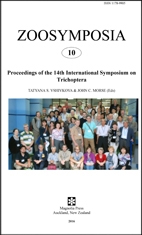Abstract
We present our current phylogenetic hypothesis on the phylogeny of Trichoptera, generated from an analysis of over 7000 nucleotides from 18S and 28S rRNA, EF-1α, COI, and CAD. We corroborate our earlier hypotheses, with results that include a monophyletic Annulipalpia, Integripalpia, Brevitentoria, and Plenitentoria. Monophyly of Psychomyioidea, Pseudoneureclipsidae, and Grumichellinae were confirmed. The "Spicipalpian" families were again found to be paraphyletic, and most closely related to Integripalpia. Ptilocolepidae was not found to be monophyletic, but support for its paraphyly was so weak that we interpret our results as unresolved. We interpret our measures of branch support, and present a collapsed phylogeny that more conservatively represents our current hypothesis. We discuss how these data can eventually be merged into other sources of data, such as COI barcode data and transcriptomes, and suggest that a single huge analysis of all data, with all taxa, is unnecessary if analyses can be phylogenetically subdivided into many separate parts, using transcriptome data to fix the deepest nodes, and allowing faster evolving data to be more appropriately targeted to nodes closer to the tips of the tree.
References
Chamorro, M.L. & Holzenthal, R.W. (2011) Phylogeny of Polycentropodidae Ulmer, 1903 (Trichoptera: Annulipalpia: Psychomyioidea) inferred from larval, pupal and adult characters. Invertebrate Systematics, 25, 219–253.
http://dx.doi.org/10.1071/IS10024Hall, N. (2007) Advanced sequencing technologies and their wider impact in microbiology. The Journal of Experimental Biology, 210, 1518–1525.
http://dx.doi.org/10.1242/jeb.001370Hebert, P.D.N., Cywinska, A., Ball, S.L. & de Waard, J.R. (2003) Biological identifications through DNA barcodes. Proceedings. Biological sciences/The Royal Society, 270, 313–321.
http://dx.doi.org/10.1098/rspb.2002.2218Holzenthal, R.W., Blahnik, R.J., Kjer, K.M. & Prather, A.L. (2007) An update on the phylogeny of caddisflies (Trichoptera). In: Bueno-Soria, J., Barba-Alvarez, R. & Armitage, B.J. (Eds.), Proceedings of the 12th International Symposium on Trichoptera. The Caddis Press, Columbus, Ohio, pp. 143–153.
Holzenthal, R.W., Morse, J.C. & Kjer, K.M. (2011) Order Trichoptera Kirby, 1813. In: Zhang, Z.-Q. (Ed.) Animal biodiversity: An outline of higher-level classification and survey of taxonomic richness. Zootaxa, 3148, 210–211.
Ivanov, V.D. (2002) Contribution to the Trichoptera phylogeny: New family tree with consideration of Trichoptera-Lepidoptera relations. In: Mey, W. (Ed.), Proceedings of the 10th International Symposium on Trichoptera, Potsdam, Germany, July 30–August 5, 2000. Nova Supplementa, Entomologica 15. Deutsches Entomologisches Institut, Goecke & Evers, Keltern, pp. 277–292.
Johanson, K.A., Malm, T., Espeland, M. & Weingartner, E. (2012) Phylogeny of the Polycentropodidae (Insecta: Trichoptera) based on protein-coding genes reveal non-monophyletic genera. Molecular Phylogenetics and Evolution, 65, 126–135.
http://dx.doi.org/10.1016/j.ympev.2012.05.029Kjer, K.M., Blahnik, R.J. & Holzenthal, R.W. (2001) Phylogeny of Trichoptera (caddisflies): Characterization of signal and noise within multiple datasets. Systematic Biology, 50, 781–816.
http://dx.doi.org/10.1080/106351501753462812Kjer, K.M., Blahnik, R.J. & Holzenthal, R.W. (2002) Phylogeny of caddisflies (Insecta, Trichoptera). Zoologica Scripta, 31, 83–91.
http://dx.doi.org/10.1046/j.0300-3256.2001.00079.xKjer, K.M. & Honeycutt, R.L. (2007) Site specific rates of mitochondrial genomes and the phylogeny of eutheria. BMC Evolutionary Biology, 7, 8.
http://dx.doi.org/10.1186/1471-2148-7-8Lemmon, A.R., Emme, S.A. & Lemmon, E.M. (2012) Anchored hybrid enrichment for massively high-throughput phylogenomics. Systematic Biology, 61, 727–744.
http://dx.doi.org/10.1093/sysbio/sys049Malm, T., Johanson, K.A. & Wahlberg, N. (2013) The evolutionary history of Trichoptera (Insecta): A case of successful adaptation to life in freshwater. Systematic Entomology, 38, 459–473l
Malm, T. & Johanson, K.A (2011) A new classification of the long-horned caddisflies (Trichoptera: Leptoceridae) based on molecular data. BMC Evolutionary Biology, 11, 10.
http://dx.doi.org/10.1186/1471-2148-11-10Mey, W. (1996) The caddisfly fauna of the Fan Si Pan mountain range in North Vietnam. 1. Descriptions of new and endemic species of the suborders Spicipalpia and Annulipalpia (Trichoptera). Beiträge zur Entomologie, 46, 39–65.
Misof, B., Liu, S., Meusemann, K., Peters, R.S., Donath, A., Mayer, C., Frandsen, P.B., Ware, J., Flouri, T., Beutel, R.G., Niehuis, O., Petersen, M., Izquierdo-Carrasco, F., Wappler, T., Rust, J., Aberer, A.J., Aspöck, U., Aspöck, H., Bartel, D., Blanke, A., Berger, S., Böhm, A., Buckley, T.R., Calcott, B., Chen, J., Friedrich, F., Fukui, M., Fujita, M., Greve, C., Grobe, P., Gu, S., Huang, Y., Jermiin, L.S., Kawahara, A.Y., Krogmann, L., Kubiak, M., Lanfear, R., Letsch, H., Li, Y., Li, Z., Li, J., Lu, H., Machida, R., Mashimo, Y., Kapli, P., McKenna, D.D., Meng, G., Nakagaki, Y., Navarrete-Heredia, J.L., Ott, M., Ou, Y., Pass, G., Podsiadlowski, L., Pohl, H., von Reumont, B.M., Schütte, K., Sekiya, K., Shimizu, S., Slipinski, A., Stamatakis, A., Song, W., Su, X., Szucsich, N.U., Tan, M., Tan, X., Tang, M., Tang, J., Timelthaler, G., Tomizuka, S., Trautwein, M., Tong, X., Uchifune, T., Walzl, M.G., Wiegmann, B.M., Wilbrandt, J., Wipfler, B., Wong, T.K., Wu, Q., Wu, G., Xie, Y., Yang, S., Yang, Q., Yeates, D.K., Yoshizawa, K., Zhang, Q., Zhang, R., Zhang, W., Zhang, Y., Zhao, J., Zhou, C., Zhou, L., Ziesmann, T., Zou, S., Li, Y., Xu, X., Zhang, Y., Yang, H., Wang, J., Wang, J., Kjer, K.M. & Zhou, X. (2014) Phylogenomics resolves the timing and pattern of insect evolution. Science, 346, 763–767.
Ross, H.H. (1967) The evolution and past dispersal of the Trichoptera. Annual Review of Entomology, 12, 169–206.
http://dx.doi.org/10.1146/annurev.en.12.010167.001125Stamatakis, A. (2006) RAxML-VI-HPC: Maximum likelihood-based phylogenetic analyses with thousands of taxa and mixed models. Bioinformatics (Oxford, England), 22, 2688–2690.
http://dx.doi.org/10.1093/bioinformatics/btl446Weaver, J.S. III. (1984) The evolution and classification of Trichoptera, Part 1: Thegroundplan of Trichoptera. In: Morse, J.C. (Ed.), Proceedings ofthe 4th International Symposium on Trichoptera. Dr. W. Junk Publishers, The Hague, pp. 413–419.
Whitfield, J.B. & Kjer, K.M. (2008) Ancient rapid radiations of insects: Challenges for phylogenetic analysis. Annual Review of Entomology, 53, 449–472.
http://dx.doi.org/10.1146/annurev.ento.53.103106.093304Wiggins, G.B. & Wichard, W. (1989) Phylogeny of pupation in Trichoptera, with proposals on the origin and higher classification of the order. Journal of the North American Benthological Society, 8, 260–276.

